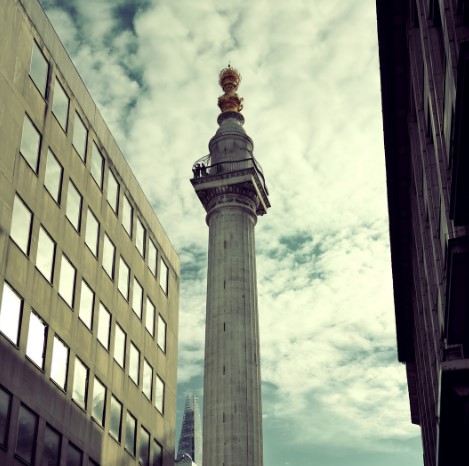
The Monument to the Great Fire of London, better known as The Monument, is a 61-metre high column that commemorates the victims who died during the Great Fire of London in 1666. It is very close to London Bridge and 61 metres from where the fire started.
History
The Fire of London took place on 2 September 1666. The fire started in a small bakery in Pudding Lane and was not extinguished until 3 days after it broke out. This catastrophe almost completely destroyed the city, saving only a few stone buildings. In 1671, plans were made to build a monument to commemorate the tragic day. They finally decided on a Doric column, which was commissioned to the architect Christopher Wren, who finished the construction in 1677.
The column
The column is made of Portland stone and measures 61 metres, which is the exact distance from the baker's house where the fateful fire started. At the top of the column is a huge flaming urn containing the ashes of the fire.
At the base of the monument are bas-reliefs and inscriptions in Latin depicting scenes that took place in the days following the fire, such as the decisions made by Charles II and the history of the construction of the monument. One of the sides explains in detail the events that took place on the day of the fire.
Inside the hollow column is a narrow spiral staircase with 345 steps leading to a terrace below the urn. This terrace is open to the public and offers impressive views of Tower Bridge and the city's financial district.
Location: Fish St Hill, London EC3R 8AH, Reino Unido - +44 20 7403 3761
Underground: Stops at Monument, Mansion House or Tower Hill stations.
También te puede interesar leer:
- Information about London. Demographics of London
- London airports
- Districts of London. Information about London
- Westminster Cathedral, London
- Shakespeare's Globe Theatre, London
- Millennium Bridge, London
- London markets
- City Hall, London. Information about London
- London markets
- Covent Garden, London
- Buckingham Palace, London. Information about London
- National Gallery, London
- Trafalgar Square, London
- Westminster Abbey, London
- Piccadilly Circus, London. Information about London
- Hyde Park, London.
- Soho, London.
- Chinatown, London. Information about London
- Palace of Westminster
- London Eye
- St Paul's Cathedral
- Tower of London
- Tower Bridge
- Big Ben.
- Health Care in the UK -¿Cómo es la asistencia sanitaria en Reino Unido?
- How can I obtain a NIN (National Insurance Number)?
- What documentation should I bring with me to the UK?
- Brexit FAQ - Frequently asked questions Brexit
- History of the flag of the United Kingdom
- Where to do language exchange in London
- How should I write the CV? - Practical advice on the CV
- The job interview - How to Prepare For an Interview





